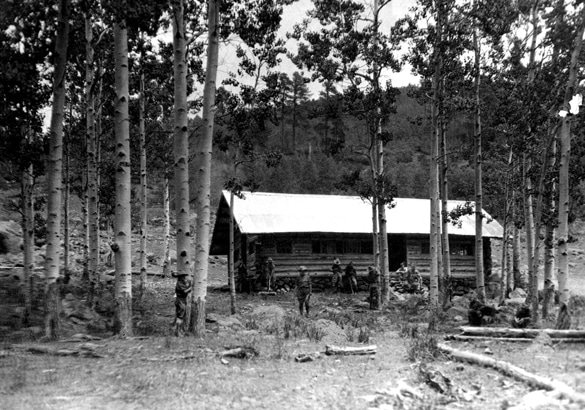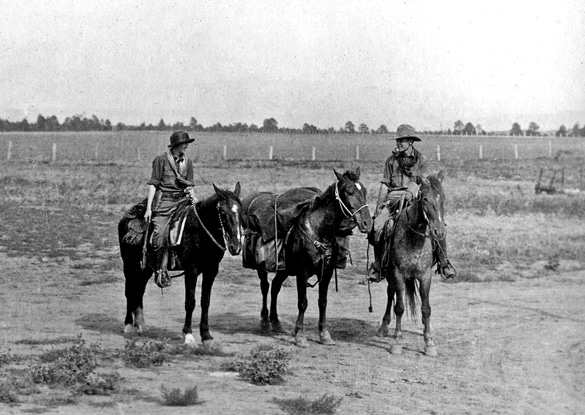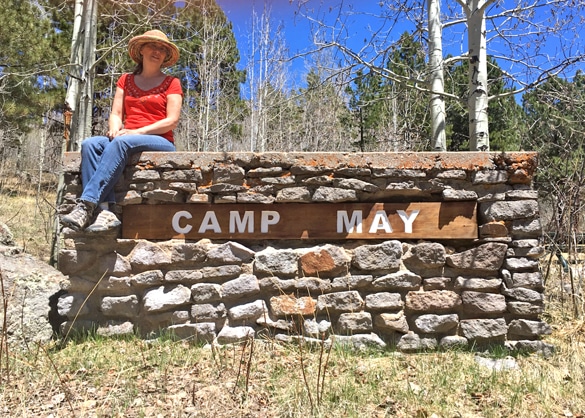
Boys from the Los Alamos Ranch School’s Spruce Patrol at Camp May (date unknown). Courtesy/Los Alamos Historical Society Archive

Peggy and Fermor Church leaving for their honeymoon at Camp May, Summer 1924. Courtesy/Los Alamos Historical Society Archive
By Sharon Sndyer
Los Alamos Historical Society
The Los Alamos County Park known as Camp May has long been enjoyed as a place for picnics, camping, hiking, birding, and many other outdoor pursuits, but a look into its history can make possible an even greater appreciation.
Camp May came into existence in the early years of the Los Alamos Ranch School (LARS) when a cabin was built in 1922-1923 on a site leased from the Forest Service. The large cabin with its stone fireplace became a popular base camp for weekend trips into the mountains and for skiing and hunting trips for the older LARS boys.
The cabin was a gift of George and Edith May of Chicago. Their son, George T. May III, was one of four graduates of the Ranch School in 1923. The generosity of the May family and the advantage of special use permits from the Forest Service helped to enlarge the school’s campus without the need to purchase more land. The Ranch School would eventually own more than 750 acres including its main campus around Fuller Lodge, but the use of thousands of acres of national forests and park land greatly enhanced the possibilities.
The year after the cabin was built, another piece of history was connected to it. Young LARS master Fermor Church and his bride, Peggy Pond Church, daughter of the school’s founder, Ashley Pond, spent their honeymoon at Camp May. To say the least, the week at the cabin was an introduction to life in the Jemez Mountains for Peggy. For a betrothal gift, Fermor gave her a Colt revolver and holster. It was no doubt a practical thought on his part, considering that he would be taking his bride to live on an isolated ranch, but Peggy remembered that she had hoped for something a little more sentimental! In her poetic way with words, Peggy wrote, “It was very plain to me / I couldn’t hit a six foot tree / but just the same, I wish my love / had given me a soft-winged dove.”
The pair left for their honeymoon on horseback, trailing a pack horse with supplies. During their week at Camp May, they hauled water from a nearby spring, were kept awake by a hailstorm pounding on the metal roof, and fought with a wood-burning stove that “smoked and smouldered.” Despite all of that, Peggy looked back fondly on those memories in later years.
Another Church family connection occurred years later when Fermor’s nephew, Herbert “Hup” Wallis, was a master at the Los Alamos Ranch School between 1938-1940. Hup left his own mark on Camp May history. In addition to clearing slopes for the LARS boys to use on Sawyer’s Hill in the Jemez Mountains southwest of the school, he created the first runs on Pajarito Mountain for the senior boys to use during their weekends at the Camp May cabin. Both ski areas were used by scientists and their families during the Manhattan Project years.
The stone fireplace is the only remnant that remains from the original Camp May cabin, and it is incorporated in the area of covered picnic tables to the left of the entry road. In these days of social distancing, the 27 acres of Camp May adjacent to Pajarito Mountain offer plenty of room for people to spread out 6 feet apart, enjoy nature, and reflect on the history of a place that has long been important to Los Alamos.

Historical Society Director Liz Martineau enjoys an afternoon at Camp May recently. Photo by Gordon McDonough

